When my grandson was visiting on a recent weekend, we took him to see The Jungle Book movie. He loved it and so did we. As the film opened…antelopes, gazelles, wildebeests, giraffes, monkeys, wolves, hyenas, jackals, rhinos, elephant, ostriches and other animals were running as if their lives depended on it.
The Jungle Book, set in India, has a tiger as a major character. I read recently Rudyard Kipling’s book has shined a light on the plight of tigers in the wild. It’s widely known tigers are prized by poachers, as are the ivory tusks of elephants and rhinos – now legally banned. 
Seeing those magnificent animals in the movie transported me back to 2010 when my partner and I went on an African safari. Tigers are not found in Africa, but the other animals in the film are there. We went to Tanzania on Africa’s eastern coast on a small group tour with Overseas Adventure Travel (OAT). Our group of 15 tourists had three guides, each with his own specialty ranging from birds to large animals to vegetation.
My appreciation for all these animals increased exponentially after the safari. Now it is difficult for me to see animals in a zoo even though many of today’s zoos are all about conservation, education and research. Still, I have no interest in going to a zoo after seeing animals roaming free in the wild.

Canal Boat in Amsterdam: Hop on & off
But I’ve gotten ahead of myself. The trip from Philadelphia to Africa is a long one as you can imagine. We wisely decided to take an optional overnight in Amsterdam — a good way to break up a long plane ride.
We arrived in Amsterdam, checked into an airport hotel, had breakfast and took a train into central city. We bought canal ride tickets, got on a canal boat and toured Amsterdam the easiest way to take in the city — from the water. Afterward, we visited the Rijksmuseum and Van Gogh Museum before enjoying an early dinner and taking the train back to the hotel for a good night’s sleep.
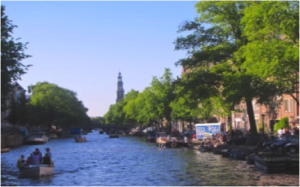
Touring Amsterdam by boat
We arrived the next day at Kilimanjaro International Airport in Tanzania and were met by our head tour guide. We spent our first two nights in Arusha, the capital of northern Tanzania widely known as the gateway for safaris. The first day, as we were getting over jet lag, we visited an amazing place near Arusha called Shanga, a residential home for people with disabilities, located on 10 acres within a coffee plantation.
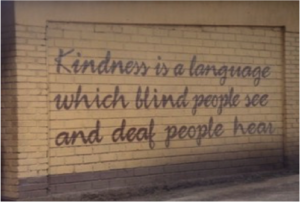
Shanga’s Motto
Some years ago, the plantation owner’s daughter started Shanga when she saw area people with disabilities didn’t have a proper place in Africa’s social/work structure. Some people at Shanga are blind, others deaf and still others are physically disabled. Residential dormitories were built and braille and sign language classes were started with all residents and teachers participating.
Cottage industries were began at Shanga including small bead work to make such gift items as coasters and holiday ornaments. There is a sewing area with sewing machines to make clothing and necklaces.
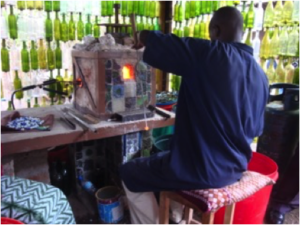
Shanga resident fires glass beads
The necklaces consist of glass beads made from old wine bottles that are broken down and melted then fired into beads by residents. The beads are feed into colorful cloth sleeves and tied to accentuate the beaded areas. All these gift items are sold in Shanga’s gift shop and there is also a restaurant on the premises. Arusha-area residents and tourists contribute to Shanga’s operating costs. While it is not self-supporting, its residents are fully functioning within their ability in a beautiful, accepting community.
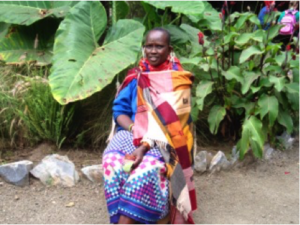
Shanga residents call her Grandma, a Maasai woman who is deaf.
Our hotel in Arusha as well as the other places we stayed were beautiful, comfortable and served delicious meals. Our favorite lodge was the three-night stay at the Ngorongoro Farm House, a former coffee plantation.
It has lovely, individual garden cottages with shared roofs surrounded by beautiful flora. Not exactly what one would expect when on safari. Even our three nights in the Serengeti tent camp were comfortable.
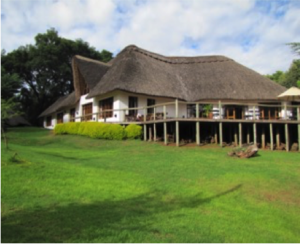
Beautiful Dining Lodge at Ngorongoro Farm House
The Farm Houses’ grounds are beautiful and include a swimming pool, organic vegetable garden, large variety of banana plants and exotic flowers. The Lodge is located just outside the Ngorongoro Conservation Area which includes a deep, volcanic crater that is the largest unflooded and unbroken caldera in the world.
The 25,000 large animals living within the crater area do not migrate as they have all the water and food needed to survive. It was here we got excited when we saw our first lions and black rhinos.
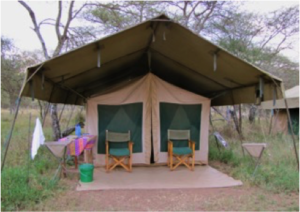 Our “tent camp” was in a designated Serengeti camping area used by OAT during their five-month “safari season.” Our tent was large and well-equipped for two people. It included a table, two chairs and cots that were more like real beds than cots.
Our “tent camp” was in a designated Serengeti camping area used by OAT during their five-month “safari season.” Our tent was large and well-equipped for two people. It included a table, two chairs and cots that were more like real beds than cots.

Eric with warm water for shower
The tent had an overhead solar-powered light, flush toilet and a warm-water shower. The shower was compliments of Eric, the friendly “shower boy,” who carefully tended a giant outdoor boiler. At the designated hour, Eric called out to us as he filled our tent’s 5-gallon bucket placed outside so it emptied into our shower inside the tent.
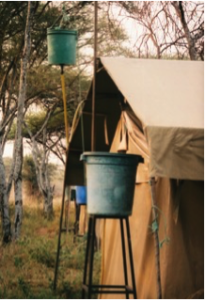
5-minute shower
We had delicious meals with fresh vegetables delivered daily.
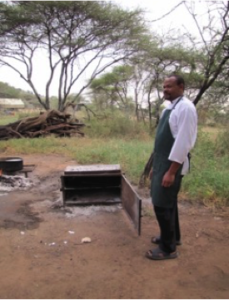
Chef bakes with outdoor oven
The camp’s superb chef cooked our meals in an improvised outdoor kitchen. While bread and other items were baked in “ovens” using firewood gathered by camp helpers, the kitchen kept food fresh in refrigeration cooled by large generators. The dining tent included a long colorful, clothed table with cloth napkins.
In my next blog, I will discuss the animals we saw in four of Tanzania’s national parks including the Serengeti.
*Safari photos by Marcia Seifert
The Takeaway: Travel can be a life changing experiences. I did not know what to expect before I went on a safari, but this trip stands out as one of the most exciting and awe-inspiring experiences I ever had. What travel experiences stand out in your mind? Share with us and let’s start a discussion. Please include your name and email address or phone number so I may contact you for clarification if I have a question. I will not publish your name. Contact me at [email protected]
